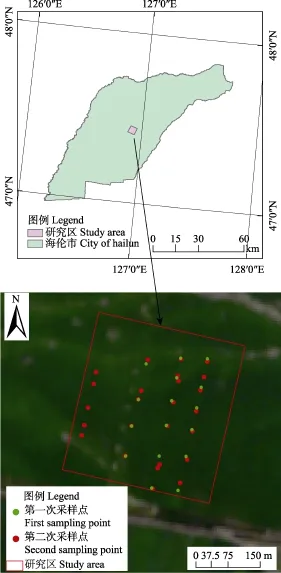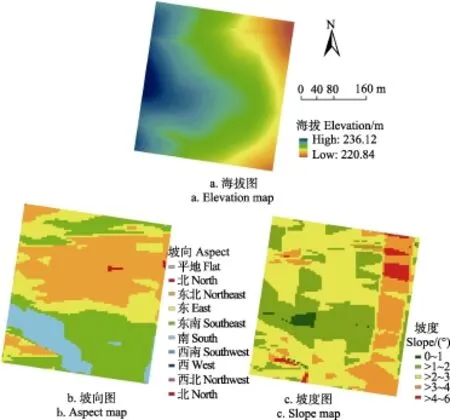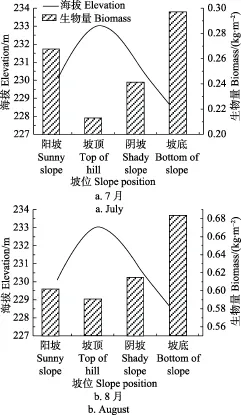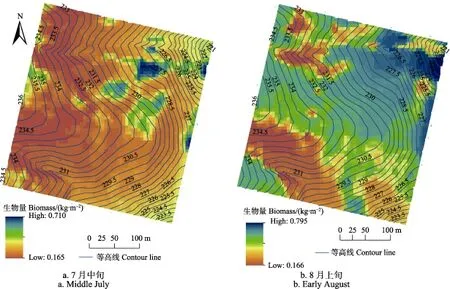引入地形因子的黑土区大豆干生物量遥感反演模型及验证
2017-09-15张新乐徐梦园刘焕军孟令华邱政超谢雅慧东北农业大学资源与环境学院哈尔滨50030中国科学院东北地理与农业生态研究所长春3002
张新乐,徐梦园,刘焕军,2※,孟令华,邱政超,潘 越,谢雅慧(. 东北农业大学资源与环境学院,哈尔滨 50030:2. 中国科学院东北地理与农业生态研究所,长春 3002)
引入地形因子的黑土区大豆干生物量遥感反演模型及验证
张新乐1,徐梦园1,刘焕军1,2※,孟令华1,邱政超1,潘 越1,谢雅慧1
(1. 东北农业大学资源与环境学院,哈尔滨 150030:2. 中国科学院东北地理与农业生态研究所,长春 130012)
为了对田块尺度农作物地上干生物量进行估测,提高大豆地上干生物量反演模型的精度和稳定性,该文获取了研究区地块2016年7、8月份的SPOT-6多光谱数据,并测定不同地形坡位的大豆地上干生物量,以归一化植被指数(normalized difference vegetation index,NDVI)和增强型植被指数(enhanced vegetation index,EVI)为输入量,建立田块尺度大豆地上干生物量一元线性回归模型;加入与地上干生物量相关的地形因子,建立逐步多元回归和神经网络多层感知反演模型。结果表明:1)使用传统的单一植被指数模型预测大豆地上干生物量有可行性,但模型精度和稳定性不高。2)加入地形因子(海拔、坡度、坡向)的神经网络多层感知器模型,有较高的精度和可靠性,模型准确度达到90.4%,验证结果显示预估精度为96.2%。反演结果与地块的地形、地貌、气温和降水特征基本吻合,反映了作物长势的空间分布特征,可以为田块尺度大豆地上干生物量动态监测和精准管理,提供借科学依据。
遥感;作物;模型;大豆;地上干生物量;地形因子
0 引 言
作物地上生物量是反映作物生长状况的重要指标,作物生物量估算是服务现代农业的一项重要内容,及时准确的生物量模拟对国家农业决策、农田生产管理、粮食仓储安全等都有重要意义[1]。传统地面调查监测的统计模型与物理模型难以实用化,无论是从时间还是从空间角度来获取生物量,都有一定难度和局限[2-6]。遥感技术可以打破这一局限,准确、无破坏的对多源信息快速提取,对生物量进行估算与制图,实现对整个生态系统的宏观监测。
目前有很多学者,用植被指数估算生物量。李素英等反演锡林浩特草原的生物量,选用基于TM影像数据建立的5种植被指数,和地上生物量建立线性及非线性模型[7]。崔霞等基于MOD09GA产品,建立17种植被指数,研究与生物量的相关性并建立草地地上生物量遥感反演模型[8]。但单一用植被指数反演生物量时还存在一些问题,比如模型因素单一,模型精度不高,普遍适用性不强。
同时,地形因子影响生物量分布。因为自然环境是植物生长更新的重要条件[9],地形左右着区域内部太阳辐射和降水的空间布局,营造出局部小气候,造成土壤质地和土壤养分、水分在不同地形条件下的差异分布,从而间接影响植被生长[10-11]。地形因子对植物分布的影响,当前已经受到了广泛关注[13-16]。Olivero 和 Hix等在研究中发现,俄亥俄州东南部不同坡向的森林,地表植物多样性不同[13];Tokuchi 等研究了西班牙东南部森林的土壤厚度和水分的空间异质性,结果表明地形因子( 坡度和海拔)是差异产生的主导因素,并对植物分布起重要作用[15]。
为解决植被指数估测生物量,因素单一和模型精度不高问题,同时考虑到地形因子对生物量分布的影响,本文拟用多光谱遥感影像,加入实测坡向、坡度、海拔等地形数据,建立大豆地上干生物量反演模型,实现田块尺度大豆长势定量监测,为农田精准管理提供依据。
1 研究区及数据源
1.1 研究区域概况
研究区位于黑龙江省绥化市海伦东兴,属寒温带大陆性气候,四季分明,全年平均降水量500~600 mm,年活动积温为2 200~2 400 ℃,平均海拔239 m,地处典型黑土区,漫川漫岗;坡面、坡顶、坡底等不同地貌类型上土壤侵蚀程度不同,加之土壤养分、水分空间差异性显著,田块内部土壤、作物长势差异大,相同的施肥方式、田间不同空间位置地上干生物量却差异明显。选取历年作物长势、产量空间差异显著的地块作为研究区(图1),面积约为13.16 hm2,地块中心经纬度为47°25′N、126°55′E,生长季节内采用一致的田间管理措施,种植作物选择大豆供试。

图1 研究区及样点布置(2016年7月7日SPOT-6真彩色影像)Fig.1 Location of study fields and sample distribution map (SPOT-6 true color image on July 7, 2016)
1.2 数据源
1.2.1 遥感数据获取与预处理
编程订购2016-07-18、2016-08-08两期SPOT-6影像,全色波段空间分辨率为1.5 m,多光谱波段空间分辨率6 m。利用ENVI5.1对影像进行辐射定标、大气校正、正射校正的处理,在ArcGIS 10.1中对影像进行裁剪。然后对裁剪后的影像进行C模型地形校正,并计算影像的归一化植被指数(normalized difference vegetation index,NDVI)和增强型植被指数(enhanced vegetation index,EVI)。
1.2.2 地形数据
2016年5月27日,使用定位精度为厘米级的海星达iRTK2对研究区地块进行实地测量。将得到的780个精确坐标和高程点,在ArcGIS中生成TIN图层,并转成分辨率为4 m的高精度DEM栅格数据,在ArcGIS中提取海拔、坡向、坡度因子(图2)。

图2 研究区地形特征Fig.2 Terrain features of study field
1.2.3 地上干生物量测定
在大豆生长期(从7月15日开始到8月14日期间)分2批次均匀采样,覆盖整个区域的41个样方,每个样方面积为2.2 m×2 m,统计每个样方内大豆株数,并在其中随机选取若干株长势均匀的样本植物,齐根剪取。在实验室中,将植物样品于80 ℃恒温烘干,获得植物地上部分干生物量。用公式(1),将其换算成采样点1 m×1 m区域内大豆的地上干生物量。单位面积内大豆的地上干生物量平均值:

式中Bj表示第j个样区单位面积内大豆地上干生物量;Bjk表示第j个样区单位面积内随机割取的m株大豆干质量;n为样区单位面积内大豆总株数;m为样区内被割取称质量的大豆株数。样本采集统计结果见表1。

表1 样区大豆干生物量描述统计量Table 1 Descriptive statistics of sampled soybean biomass
1.3 模型构建
随机选取41个样点中的28个用来建模,13个样本校验。选取3种方法建立模型,分别为一元线性、多元回归、神经网络多层感知器模型。
1.3.1 一元线性模型
植被指数法是光学遥感估算植被生物量常用的经验方法。而在地形复杂区域,SR(simple ratio,SR)和 NDVI是最常用的基于近红外与红光波段比值形式的植被指数,可以消除大量的地形影响[17]。选取目前应用最为广泛的归一化差值植被指数NDVI,考虑到,NDVI可能会达到饱和并处于稳定阶段,而EVI不容易饱和[18]。因此,选取增强型植被指数EVI,2种植被指数进行对比分析。
选择应用以上2种植被指数与大豆地上干生物量进行相关性分析,并建立一元线性模型估算大豆地上干生物量。
1.3.2 多元回归模型
作物生物量不光与植被反射光谱信息有关,和地学因子也有密切关系[19-22]。选择植被指数、海拔、坡度、坡向等地形因子,作为变量,构建大豆地上干生物量估测模型。模型构建前,为避免输入变量之间的相关性的影响,减少变维系数,先对上述变量进行主成分提取。建立基于主成分的大豆地上干生物量反演模型。多元线性回归方程一般表达式是

式中ε是随机项,服从正态分布N(0,σ2)。本文中,因变量y是干生物量,β0为常数项,βk(k=1,2,…,k)为回归系数,Xk(k =1,2,…,k)为筛选出的高相关性的变量因子。
1.3.3 神经网络多层感知器MLP模型
在人工神经网络中,多层感知器(multi-layer perceptron,MLP)是运用最广泛的一种模型[23]。一个典型的神经网络由3部分组成:输入层(input layer)、隐含层(hidden layer)和输出层(output layer)。神经网络的输出值yσ如式(3)

式中h是激活函数,bj和B分别是“输入层到隐藏层”和“隐藏层到输出层”这两步函数的偏差,wij是第j个输入层单元到第i个隐含层的权重,wj是第j个隐含层单元到输出层的权重.xi表示输入参数,ni表示xi个数,nH表示隐藏层节点数。利用一系列数据对神经网络进行训练,寻找最佳权重w使得目标函数E最小。
1.3.4 模型精度评价
采用均方根误差(root-mean-square error,RMSE)和决定系数(determination coefficient,R²)分析模型的精度,确定最优反演模型。RMSE的数值越低,表明模型越精确;R²越接近于1,表示模型的参考价值越高[24-25]。
2 结果与分析
2.1 地形对大豆地上干生物量的影响
根据研究区不同地形特征(图2),选取具有阳坡、坡顶、阴坡和坡底连续地形变化的采样点,统计4个地形坡位的样点生物量,得出生物量干生物量变化特征(图3)。根据与不同坡位之间的关系,能直观反映出大豆在不同地形条件下的生长状况,7、8月份不同时期地上干生物量在4个坡位上的海拔和地上干生物量均值变化。

图3 不同坡位海拔及大豆地上干生物量分布特点Fig.3 Elevation and distribution of soybean dry biomass of different slope positions
7月中旬阳坡的地上干生物量均值为0.27 kg/m2,坡顶干生物量均值最小为0.23 kg/m2,(图3)最大均值出现在坡底,地上干生物量指标均值坡底大于阳坡,大于阴坡和坡顶。阳坡和坡底干生物量均值最大,可能是研究区大豆在生长前期(5月中旬至6月末,大豆出苗和拔节期),对光照、温度和水分要求较高,而阳坡光照时间较长、坡底有机质和水分充足,对大豆生长具有正面影响,因此生物量在阳坡和坡底积累较多。8月上旬阳坡的地上干生物量均值0.60 kg/m2,坡顶均值最小,阴坡为0.62 kg/m2(图3),地上干生物量均值坡底和坡顶相差0.093 kg/m2。进入8月份,样本区整体生物量较7月份有较大提高,但是不同坡位生物量积累在图中表现较大差异,说明地形是造成该地区生物量分布差异的重要因素。
2.2 地上干生物量反演模型及精度验证
根据多光谱影像、实地测量地形数据和试验区实测地上干生物量建立的回归模型(表2)可知,2种遥感植被指数EVI和NDVI与地上干生物量建立的一元线性模型中,NDVI拟合度较高,R²达到0.712。选用NDVI与相关地形因子建立的多元线性回归和神经网络多层感知器模型,R²分别为0.716、0.904,RMSE分别为0.116、0.047 kg/m2。神经网络多层感知模型R² 明显高于其他遥感模型,RMSE较其他模型低。
对13个样区验证结果显示,神经网络模型反演的整个验证区总地上干生物量的平均绝对误差和平均相对误差均最小,为0.113 kg/m2和0.212;神经网络多层感知器模型的平均相对误差比一元线性模型降低18.2%(表2)。因此,在3类反演模型中,神经网络模型的反演结果最接近实际情况。

表2 地上干生物量预测模型及精度评价Table 2 Model accuracy evaluation for aboveground biomass
2.3 地上干生物量空间分布制图与分析
使用NDVI、海拔、坡度、坡向因子做为模型输入量的神经网络模型,反演整个研究区大豆生长期7月中旬到8月上旬地上干生物量分布。结果显示,7月中旬该地区大豆地上干生物量略高的区域主要分布在东部(图4);8月上旬开始,地区干生物量总体升高,西南部和西北坡度大的地区,大豆地上干生物量明显低于周边地区。
对应研究区大豆生长周期,7、8月是大豆生殖发育的关键时期。7月中旬之前,大豆处于生长发育初期,经历了拔苗和开花拔节时期,地上干生物量积累较少,整体差异并不十分明显。7月下旬开始,大豆生长逐渐进入到结荚抽雄、吐丝抽穗期,东部地区,地形整体平坦,海拔坡度较低,水肥保持能力较西部地区强,不具有针对性的统一施肥管理,使得地上干生物量积累的差异随之越来越明显,至8月上旬,东部地区干生物量整体偏高,沟谷地区因为坡度大,地形复杂,水肥保持能力差,地上干生物量积累一直偏低。该空间分布模式与研究区实际情况较为一致。

图4 大豆生物量空间分布Fig.4 Spatial distribution of soybean biomass
3 讨 论
当今,遥感技术普遍应用到农业上,通过遥感卫星、激光雷达、无人机等进行森林、湿地、草原等生物量数据获取,前人已研究过并获得了大量成果。然而利用多光谱数据获取,进行小尺度高精度的农作物地上生物量反演还较少。植被指数NDVI能够反演作物生长前期生物量,但到了后期呈现饱和状态,此时作物生长积累的生物量难以准确反映[28-30]。因此,引入EVI与之对比,结果显示以NDVI为自变量的模型精度较高。研究利用遥感指示因子,同时选取生物量相关的多种地形因子进行模型的构建,尽可能减少了单一使用NDVI估测生物量所存在的间接性和饱和性问题。
本文为减少样点布局数量、定位精度、生物量测定误差对生物量估算的影响[26-28],按照作物不同长势的实际状况均匀布设样点,样方数据中包括区域中较小生物量和较大生物量的群落,样点中心定位和地形因子测量都严格按照调查规范执行,生物量测量取多次结果平均值[26]。在此基础上结合遥感影像,建立大豆地上生物量估测模型,为监测田间大豆群体生长状况,田间精准管理提供简单实用的方法,最终达到针对性提高大豆地上生物量的目的。
尽管如此,准确估算不同作物生物量是个相当复杂的问题,首先,模型因子提取归一化植被指数,在地形复杂地区,归一化植被指数的准确性和普遍性难以保证;其次,通过高精准实测地形数据获取地形因子来反演生物量,只适用于中小范围,想要大面积区域反演植物生物量并保证精度是很难做到的;最后,由于影像原始数据信息量大,地形不平坦地区实测地形数据信息冗余度高等因素,带来了数据处理和分析的复杂和难度。
4 结 论
本文建立了大豆地上干生物量多种估测模型,在精度验证后选择最佳模型进行反演填图,并和作物实际生长分析对比,研究结果表明:1)神经网络模型反演地块尺度大豆地上干生物量能够取得较高的精度;2)7月份生物量整体较8月份小,地块植被呈现“东部略高于西部,整体差异尚不明显”的分布格局,8月份上旬开始,田块地上干生物量整体增高,南部阴坡坡底地区地上干生物量明显大于阳坡3)坡度大,地形陡峭地区,水肥流失较严重,地上干生物量明显低于其他地区;4)地形是造成该区域地上干生物量空间分布差异的重要因素。在大豆生长前期的管理中,若能充分考虑地形对太阳辐射和降水的空间再分配,有针对性的进行田间精准施肥和管理,优化经营方式,将有助于生物量的整体增长和产量的显著提高。
[1] 谭正,刘湘南,张晓倩,等.作物生长模型同化SAR数据模拟作物生物量时域变化特征[J].中国农学通报,2011,27(27):161-167. Tan Zheng, Liu Xiangnan, Zhang Xiaoqian, et al. Simulation of dynamics of crop biomass by assimulation SAR data into crop growth model[J]. Chinese Agricultural Science Bulletin, 2011, 27(27): 161-167. (in Chinese with English abstract)
[2] 王建步,张杰,马毅,等. 基于高分一号WFV卫星影像的黄河湿地草本植被生物量估算模型研究[J]. 激光生物学报,2014(6):604-608. Wang Jianbu, Zhang Jie, Ma Yi, et al. Study on the above ground vegetation biomass estimation model based on GF-1WFV satellite image in the yellow river estuary wetland[J]. Journal of Laser Biological, 2014(6): 604-608. (in Chinese with English abstract)
[3] 曾晶,张晓丽. 高分一号遥感影像下崂山林场林分生物量反演估算研究[J]. 中南林业科技大学学报,2016,36(1):46-51 Zeng Jing, Zhang Xiaoli. Laoshan forest biomass estimation based on GF-1 images with inversion algorithm[J]. Journal of Central South University of Forestry & Technology, 2016, 36(1): 46-51. (in Chinese with English abstract)
[4] 赵天舸,于瑞宏,张志磊,等. 湿地植被地上生物量遥感估算方法研究进展[J]. 生态学杂志,2016,35(7):1936-1946. Zhao Tiange, Yu Ruihong, Zhang Zhilei, et al. Estimation of wetland vegetation aboveground biomass based on remote sensing data: A review[J]. Chinese Journal of Ecology 2016, 35(7): 1936-1946. (in Chinese with English abstract)
[5] 高明亮,赵文吉,宫兆宁,等. 基于环境卫星数据的黄河湿地植被生物量反演研究[J]. 生态学报,2013,33(2):542-553. Gao Minglian, Zhao Wenji, Gong Zhaoning, et al. The study of vegetation biomass inversion based on the HJ satellite data in Yellow River wetland[J]. Acta Ecologica Sinica, 2013, 33(2): 542-553. (in Chinese with English abstract)
[6] 刘芳,冯仲科,赵方,等. 资源三号遥感卫星影像的生物量反演研究[J]. 西北林学院学报,2015,30(3):175-181. Liu Fang, Feng Zhongke, Zhao Fang, et al. Biomass inversion study of ZY-3 remotesensing satellite imagery[J]. Journal of Northwest Forestry Univerisity, 2015, 30(3): 175-181. (in Chinese with English abstract)
[7] 李素英,李晓兵,莺歌,等. 基于植被指数的典型草原区生物量模型: 以内蒙古锡林浩特市为例[J]. 植物生态学报,2007,31(1):23-31. Li Suying, Li Xiaobing, Ying Ge, et al. Vegetation indexesbiomass models for typical semi-arid steppe: A case study for xilinhot in northern china[J]. Chinese Journal of Plant Ecology, 2007, 31(1): 23-31. (in Chinese with English abstract)
[8] 崔霞,梁天刚,刘勇. 基于MOD09GA产品的草地生物量遥感估算模型[J]. 兰州大学学报:自然科学版,2009,45(5):79-87. Cui Xia, Liang Tiangang, Liu Yong. Modeling of aboveground biomass of grassland using remotely sensed MOD09GA data[J]. Journal of Lanzhou university: Natural Science Edition[J], 2009, 45(5): 79-87. (in Chinese with English abstract)
[9] Aasen H, Bending J, Bolten A, et al. Intruduction and preliminary results of calibration for full-frame hyperspectral cameras to monitor agricultural crops with UAVs[J]. ISPRSInternatioanl Archives of the Photogrammetry, Remote Sening and Spatial Information Sciences, 2014, 7(7): 1-8.
[10] Cantón Y, Del Barrio G, Solé-Benet A, et al. Topo-graphic controls on the spatial distribution of ground cover in the Tabernas badlands of SE Spain[J]. Catena, 2004, 55: 341-365. [11] Parker A J, Branner J C. The topographic relative mois-ture index: An approach to soil-moisture assessment inmountain terrain[J]. Physical Geography, 1982, 3: 160-168.
[12] Valtera M, Šamonil P, Svoboda M, et al. Effects of topography and forest stand dynamics on soil morphology in three natural Picea abies, mountain forests[J]. Plant & Soil, 2015, 392(1/2): 57-69.
[13] Olivero A M, Hix D M. Influence of aspect and stand ageon ground flora of southeastern Ohio forest ecosystems[J]. Plant Ecology, 1998, 139: 177-187.
[14] Brosofske K D, Chen J, Crow T R. Understory vegetationand site factors: Implications for a managed Wisconsin landscape[J]. Forest Ecology and Management, 2001, 146: 75-87.
[15] Tokuchi N, Takeda H, Yoshida K, et al. Tpographical variations in a plant-soil system along a slope on MtRyuoh, Japan[J]. Ecological Research, 1999, 14: 361-369.
[16] Lewis K J, Trummer L M, Thompson R D. Incidence oftomentosus root disease relative to spruce density andslope position in south-central Alaska[J]. Forest Ecologyand Management, 2004, 194: 159-167.
[17] 朱高龙,柳艺博, 居为民,等. 4种常用植被指数的地形效应评估[J]. 遥感学报,2013,17(1):210-234. Zhu Gaolong, Liu Yibo, Ju Weimin, et al. Evaluation of topographic effects on four commonly used vegetationindices[J]. Journal of Remote Sensing, 2013, 17(1): 210-234. (in Chinese with English abstract)
[18] 刘焕军,孟令华,张新乐,等. 基于时间序列Landsat影像的棉花估产模型[J]. 农业工程学报,2015,31(17):215-220. Liu Huanjun, Meng Linghua, Zhang Xinle, et al. Estimation model of cotton yield with time series Landsat images[J]. Transactions of the Chinese Society of Agricultural Engineering (Transactions of the CSAE), 2015, 31(17): 215-220. (in Chinese with English abstract)
[19] 郑光,田庆久,陈镜明,等. 结合树龄信息的遥感森林生态系统生物量制图[J]. 遥感学报,2006,10(6):932-940. Zheng Guang, Tian Qingjiu, Chen Jingming, et al. Combining remote sening imagery and forest age inventory for biomass mapping[J]. Journal of Remote Sensing, 2006, 10(6): 932-940. (in Chinese with English abstract)
[20] Vauhkonen J, Næsset E, Gobakken T. Deriving airborne laser scanning based computational canopy volume for forest biomass and allometry studies[J]. Isprs Journal of Photogrammetry & Remote Sensing, 2014, 96(11): 57-66.
[21] 刘海丰,薛达元, 桑卫国. 地形因子对暖温带森林群落物种丰富度-地上生物量关系的影响[J]. 生态环境学报,2012,21(8):1403-1407.Liu Haifeng, Xue Dayuan, Sang Weiguo. Effect of topographic factors on the relationship between species richness and aboveground biomass in a warm temperate forest[J]. Ecology & Environmental Sciences, 2012, 21(8): 1403-1407. (in Chinese with English abstract)
[22] 侯兆疆,赵成章,李钰,等. 高寒退化草地狼毒种群地上生物量空间格局对地形的响应[J]. 生态学杂志,2013,32(2):253-258. Hou Zhaojiang, Zhao Chengzhang, Li Yu, et al. Responses of the spatial pattern of Stellera chamaejasme's aboveground biomass to topography in degraded alpine grassland[J]. Chinese Journal of Ecology, 2013, 32(2): 253-258. (in Chinese with English abstract)
[23] Jain A K, Mao J C, Mohiuddin K M. Artificial neuralnetworks-a tutorial[J]. Computer, 1996, 29(3): 31-44.
[24] 冯琦胜,高兴华,黄晓东,等. 2001-2010 年青藏高原草地生长状况遥感动态监测[J]. 兰州大学学报:自然科学版,2011,47(4):75-90. Feng Qisheng, Gao Xinghua, Huang Xiaodong, et al. Remote sensing dynamic monitoring of grass growth in Qinghai-Tibet plateau from 2001 to 2010[J]. Journal of Lanzhou University Natural Sciences, 2011, 47(4): 75-90. (in Chinese with English abstract)
[25] 南锋,朱洪芬,毕如田. 黄土高原煤矿区复垦农田土壤有机质含量的高光谱预测[J]. 中国农业科学,2016,49(11):2126-2135. Nan Feng, Zhu Hongfen, Bi Rutian. Hyperspectral prediction of soil organic matter content in the Reclamation cropland of Coal Mining Areas in the Loess Platesu [J]. Scientia Agricultura Sinica, 2016, 49(11): 2126-2135. (in Chinese with English abstract)
[26] Song C. Optical remote sening of forest leaf area index and biomass[J]. Progress in Physical Geography, 2013, 37(1): 98-113.
[27] 吴继忠,吴玮. 基于GPS-IR的美国中西部地区NDVI时间序列反演[J]. 农业工程学报,2016,32(24):183-188. Wu Jizhong, Wu Wei. Retrieving NDVI in Midwestern America using GPS-interferometric reflectometry[J]. Transactions of the Chinese Society of Agricultural Engineering (Transactions of the CSAE), 2016, 32(24): 183-188. (in Chinese with English abstract)
[28] 郭志华,彭少麟,王伯荪. 利用TM数据提取粤西地区的森林生物量[J]. 生态学报,2002,22(11):1832-1839. Guo Zhihua, Peng Shaolin, Wang Bosun. Estimating forest biomass in western Guangdong using landsat TM data[J]. Acta Ecologica Sinica, 2002, 22(11): 1832-1839. (in Chinese with English abstract)
[29] 冯仲科,刘永霞. 森林生物量测定精度分析[J]. 北京林业大学学报,2005,27(增刊2):108-111. Feng Zhongke, Liu Yongxia. Precision analysis of forest biomass measuring[J]. Journal of Beijing Forestry University, 2005, 27(S2): 108-111. (in Chinese with English abstract)
[30] 徐小军,杜华强,周国模,等. 基于遥感植被生物量估算模型自变量相关性分析综述[J]. 遥感技术与应用,2008,23(2):239-247. Xu Xiaojun, Du Huaqiang, Zhou Guomo, et al. Review on correlation analysis of independent variables in estimation models of vegetation biomass based on remote sensing[J]. Remote Sensing Technology and Application, 2008, 23(2): 239-247. (in Chinese with English abstract)
Remote sensing inversion models and validation of aboveground biomass in soybean with introduction of terrain factors in black soil area
Zhang Xinle1, Xu Mengyuan1, Liu Huanjun1,2※, Meng Linghua1, Qiu Zhengchao1, Pan Yue1, Xie Yahui1
(1. College of Resources and Environmental Sciences, Northeast Agricultural University, Harbin 150030, China; 2. Northeast Institute of Geography and Agroecology, Chinese Academy of Sciences, Changchun 130012, China)
Crop biomass plays an important role in food security and global carbon cycle. Achieving the timely and accurate monitoring of biomass is vital for precise and reasonable agricultural management. Undoubtedly, remote sensing technique has been proven to be an effective tool for biomass estimation. Along with traditional means, it reduces the actual operation and investigation of ground surveys. In ordered to accurately estimate the crop aboveground biomass at the field scale and improve the precision and stability of soybean aboveground biomass inversion model, this paper obtained SPOT-6 6-meter multi-spectral data on July and August 2016 of the study area, as well as the soybean aboveground biomass of different terrain slopes. At the same time, the terrain data of the study area were measured and the topographic factors such as elevation, slope and aspect were extracted. We intended to use above measured data to build three models, which were the traditional linear regression model, the multiple regression model and the neural network model. Firstly, the correlation of the relationships between enhances vegetation index (EVI), normalized difference vegetation index (NDVI) and observed date of soybean aboveground biomass were analyzed by linear regression model. Then we added the terrain factors which were related to the aboveground biomass for establishing multilayer perception stepwise multiple regression and neural network inversion model. Through the model accuracy comparison and estimation accuracy analysis, the results were following: 1) In the linear regression model established by the two vegetation indexes, NDVI Model fitting degree was higher then EVI, and the coefficient of determination (R2) reached 0.712, plus root mean square error (RMSE) was 0.116 kg/m2. The results could be explained that the use of traditional single vegetation index model to predict soybean aboveground biomass was feasible. 2) The neural network multilayer sensor model had the highest precision and reliability among all above (R²= 0.904, RMSE = 0.047 kg/m2). The results of model validation showed that the average absolute and relative error of using neural network model were the smallest, and the values were 0.113 kg/m² and 0.212, respectively. In the three types of inversion models, the inversion results of the neural network model were closest to the actual data of crop aboveground biomass distribution. The inversion results of this study were in good agreement with the terrain, topography, temperature and precipitation characteristics of the plot and accurately reflected the space distribution features of crop condition and growth. Our research provided a reliable and scientific basis for dynamic monitoring and precise management of soybean aboveground biomass. The method was meaningful in precision agriculture, especially in yield and production prediction.
remote sensing; crops; models; soybean; aboveground biomass; terrain factors
10.11975/j.issn.1002-6819.2017.16.022
TP79;S127
A
1002-6819(2017)-16-0168-06
张新乐,徐梦园,刘焕军,孟令华,邱政超,潘 越,谢雅慧. 引入地形因子的黑土区大豆干生物量遥感反演模型及验证[J]. 农业工程学报,2017,33(16):168-173.
10.11975/j.issn.1002-6819.2017.16.022 http://www.tcsae.org
Zhang Xinle, Xu Mengyuan, Liu Huanjun, Meng Linghua, Qiu Zhengchao, Pan Yue, Xie Yahui. Remote sensing inversion models and validation of aboveground biomass in soybean with introduction of terrain factors in black soil area[J]. Transactions of the Chinese Society of Agricultural Engineering (Transactions of the CSAE), 2017, 33(16): 168-173. (in Chinese with English abstract) doi:10.11975/j.issn.1002-6819.2017.16.022 http://www.tcsae.org
2017-04-23
2017-06-13
国家自然科学基金项目(41671438;41501357);“中国科学院东北地理与农业生态研究所 ”引进优秀人才项目
张新乐,女,黑龙江鸡西人,副教授,博士。主要研究方向:生态遥感。哈尔滨 东北农业大学资源与环境学院,150030。
Email:xinlezhang@yeah.net
※通信作者:刘焕军,男,黑龙江穆棱人,副教授,博士,博士生导师。主要研究方向:地物高光谱遥感。哈尔滨 东北农业大学资源与环境学院,150030。Email:huanjunliu@yeah.net
